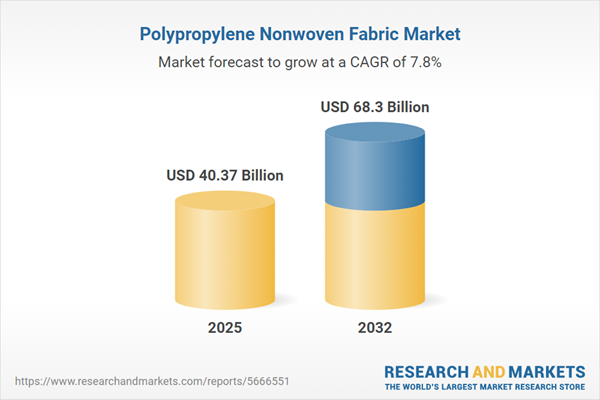Speak directly to the analyst to clarify any post sales queries you may have.
The polypropylene nonwoven fabric market is emerging as a core catalyst for modern industrial growth, enabling senior decision-makers to address efficiency, compliance, and sustainability priorities across diverse application sectors.
Market Snapshot: Polypropylene Nonwoven Fabric Market Growth Trajectory
The global polypropylene nonwoven fabric market continues a strong upward trajectory, with revenue expected to rise from USD 37.44 billion in 2024 to USD 40.37 billion by 2025, ultimately reaching USD 68.30 billion in 2032. Supported by a compound annual growth rate (CAGR) of 7.80%, this market expansion is underpinned by consistent demand from hygiene, medical, construction, automotive, and filtration sectors. Investments in manufacturing innovation and adoption of flexible technologies are streamlining compliance and supporting tailored solutions. As supply chains become more complex, market leaders are leveraging technical advancements to strengthen resilience and meet greater sustainability expectations in both established and emerging regional markets.
Scope & Segmentation: Polypropylene Nonwoven Fabric Market Dimensions
Detailed analysis of the polypropylene nonwoven fabric market provides actionable insights for organizations seeking to optimize strategy, compliance, and agility. By understanding key market dimensions, senior stakeholders can better align organizational capabilities with shifting industry requirements and sector-specific opportunities.
- Application Areas: Encompasses agricultural crop covers for yield improvement, automotive interiors for occupant safety, construction insulation, high-efficiency air and liquid filtration, hygiene products such as diapers and sanitary napkins, and medical disposables including gowns, masks, headwear, and foot covers. Each area demands specialized material properties that support regulatory alignment, product lifespan, and technical reliability.
- Technologies: Includes manufacturing methods such as meltblown for filter media, spunbond for structural durability, needlepunch for custom textures, SMS (spunbond-meltblown-spunbond) for multi-layer protection, and spunlace for enhanced softness. The technology mix enables organizations to engineer products for precise performance and compliance standards.
- Raw Material Base: Incorporates both virgin and recycled polypropylene, supporting compliance with environmental regulations, accelerating sustainability initiatives, and furthering participation in circular economy models.
- Product Weight: Offers heavyweight, mediumweight, and lightweight variants to fulfill durability, comfort, and lifecycle demands in various industrial and consumer applications.
- Distribution Channels: Includes direct sales, partner and distributor networks, e-commerce platforms, and local retail strategies, creating robust, adaptable supply routes and reducing lead times for end users.
- Regional Perspectives: Covers the Americas, Europe, Middle East & Africa, and Asia-Pacific, with each region presenting specific opportunities in regulatory compliance, localized product innovation, and investment prioritization tailored to growth objectives.
- Industry Competitors: Highlights key players such as Berry Global Group, Freudenberg SE, Ahlstrom-Munksjö Oyj, Fitesa S.A., Fibertex Nonwovens, Pegas Nonwovens, Toray Industries, Johns Manville, DuPont de Nemours, and Suominen Corporation, whose advancements shape sector benchmarks and drive competitive positioning.
Key Takeaways: Strategic Insights for Market Leaders
- Advanced manufacturing processes are essential for adapting products to evolving operational needs, ensuring readiness for future compliance and performance demands.
- Proactive assessment of raw material streams, spanning both virgin and recycled sources, supports ongoing regulatory compliance and the effective incorporation of sustainability priorities into core business functions.
- Robust sourcing and procurement strategies protect organizational stability by enabling faster responses to potential disruptions and helping to future-proof operations in fluctuating regulatory environments.
- Customized regional initiatives, developed in coordination with local standards and technical regulations, enhance operational responsiveness and reinforce positioning within target geographies.
- Strategic partnerships with technology innovators and research institutions enable faster integration of new solutions, preparing organizations for rapid regulatory shifts and changing technical demands.
- Consistent focus on sustainable operations and supply chain flexibility supports stakeholder trust and minimizes exposure to evolving regulatory and operational risks.
Tariff Impact: Navigating United States Measures in 2025
Forthcoming changes in United States tariff policy make it critical for organizations to reexamine sourcing strategies for polypropylene nonwoven fabric. Emphasis should be placed on strengthening domestic supplier relationships, diversifying sourcing channels, and deploying stringent supplier evaluation protocols to ensure ongoing compliance and operational continuity as trade measures are updated.
Methodology & Data Sources
The research synthesis combines executive-level interviews, leading trade publication insights, regulatory and patent analysis, as well as in-depth studies of import-export trends and sustainability practices. This multi-source methodology ensures that findings are grounded in perspectives relevant to organizational leadership.
Why This Report Matters
- Equips segment leaders in polyolefins and nonwovens with insights for strategic and operational improvement.
- Facilitates proactive management of complex global supply and compliance conditions, helping organizations prepare for shifting customer expectations and evolving market landscapes.
- Drives forward sustainability goals with a structured framework consistent with current industry benchmarks and stakeholder requirements.
Conclusion
By adopting technological advancements and optimizing procurement in the polypropylene nonwoven fabric sector, senior leaders can drive organizational growth, enhance flexibility in meeting regulatory change, and advance sustainability objectives across diverse markets.
Additional Product Information:
- Purchase of this report includes 1 year online access with quarterly updates.
- This report can be updated on request. Please contact our Customer Experience team using the Ask a Question widget on our website.
Table of Contents
3. Executive Summary
4. Market Overview
7. Cumulative Impact of Artificial Intelligence 2025
Companies Mentioned
The companies profiled in this Polypropylene Nonwoven Fabric market report include:- Berry Global Group, Inc.
- Freudenberg SE
- Ahlstrom-Munksjö Oyj
- Fitesa S.A.
- Fibertex Nonwovens A/S
- Pegas Nonwovens a.s.
- Toray Industries, Inc.
- Johns Manville Corporation
- DuPont de Nemours, Inc.
- Suominen Corporation
Table Information
| Report Attribute | Details |
|---|---|
| No. of Pages | 187 |
| Published | November 2025 |
| Forecast Period | 2025 - 2032 |
| Estimated Market Value ( USD | $ 40.37 Billion |
| Forecasted Market Value ( USD | $ 68.3 Billion |
| Compound Annual Growth Rate | 7.8% |
| Regions Covered | Global |
| No. of Companies Mentioned | 11 |









